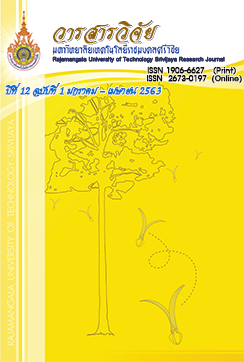Nora Rong Khru Rite of Song Pinong Silapa Ban Trang Troupe, Mayo District, Pattani Province
Keywords:
Nora Rong Khru Rite, song pinong silapa ban trang troupe, PattaniAbstract
This research aimed: 1) to study the historical background, element and performance pattern of Nora Rong Khru Rite of Song Pinong Silapa Ban Trang Troupe, Mayo District, Pattani Province, and 2) to determine the identity of Nora Rong Khru Rite of Song Pinong Silapa Ban Trang Troupe, Mayo District, Pattani Province. Data for the study were collected from documentary studies, field observations, interviews with individuals involved, and hand-on practice in dance postures from Mrs. Prim Kaewthong.
The results of the study revealed that the troupe was the only performance group which was headed by a female master. The group has been performing the art for the last 29 years. The performing art has been inherited from Inkaew Nora Rong Khru troupe that originated from a male master of renowned Nora Samthong troupe during the reign of King Rama I, 200 years ago (B.E. 2353/1810 A.D.). The major elements of the troupe consisted of 8 performers, i.e. two female Nora masters, 1 actor, and 5 choruses. There were three types of costumes for performance, ‘Kheangsai,’ ‘Khreaung Boh,’ and those for the clowns. Accompanying music was played with folk musical instruments for 43 catchphrases divided into 31 and 12 verse styles with 20 tunes. Dance postures ranged from squatting on the floor to standing posturer with slow to moderate tempo. The instruments used in the performance were Kris, Chawala lamp, Pae, Saeng, betel leaf, coconut floral offerings, and Sad Khla (mat). The rite was performed during the 6th, 7th and 9th lunar months of the year. The unique appearance of the Nora show was a mixture of performance between Nora Rong Khru, Nora Khaek and Majong theatre. In addition, the performance of Nora Rong Khru also reflected the role of female Nora in creating a sense of community bond, love and adaptation of culture in the society, which contributed to the harmony of multiculturalism of Thai Buddhists and Thai Muslims.
References
งามพิศ สัตย์สงวน. 2539. การวิจัยทางมานุษยวิทยา. จุฬาลงกรณ์มหาวิทยาลัย, กรุงเทพฯ.
จินตนา หนูณะ. 2533. บทบาทและการเสื่อมสลายของรองแง็งตันหยง. วิทยานิพนธ์ปริญญานิเทศศาสตรมหาบัณฑิต, จุฬาลงกรณมหาวิทยาลัย.
ฐิติรัตน์ เกิดหาญ. 2559. นาฏศิลป์ไทย. สกายบุ๊ก, ปทุมธานี.
ทรงคุณ จันทจร. 2556. ทฤษฏีวัฒนธรรมและสังคม. เอกสารประกอบการสอน รายวิชา 1605 902. สถาบันวิจัยศิลปะและวัฒนธรรมอีสาน, มหาวิทยาลัยสารคาม.
พิทยา บุษรารัตย์. 2535. โนราโรงครูท่าแค อำเภอ เมือง จังหวัดพัทลุง. วิทยานิพนธ์ศิลปศาสตรมหาบัณฑิต, มหาวิทยาลัยศรีนครินทรวิโรฒ.
ศิราพร ฐิตะฐาน ณ ถลาง. 2537. การศึกษาคติชนในบริบทสังคมไทย. มติชน, กรุงเทพฯ.
สันติชัย แย้มใหม่. 2556. มายาคติทางเพศผ่านสัญญะในพิธีโนราโรงครู. วิทยานิพนธ์ปริญญาศิลปศาสตรมหาบัณฑิต, มหาวิทยาลัยสงขลานครินทร์.
สุภางค์ จันทวานิช. 2551. ทฤษฎีสังคมวิทยา. จุฬาลงกรณ์มหาวิทยาลัย, กรุงเทพฯ.
สุมิตร เทพวงษ์. 2548. นาฏศิลป์ไทย: นาฏศิลป์สำหรับครูประถมศึกษา. พิมพ์ครั้งที่ 2. โอเดียนสโตร์, กรุงเทพฯ.
สุรพล วิรุฬห์รักษ์. 2547. หลักการแสดงนาฏยศิลป์ปริทัศน์. พิมพ์ครั้งที่ 1. จุฬาลงกรณ์มหาวิทยาลัย, กรุงเทพฯ.
Downloads
Published
How to Cite
Issue
Section
License
The content and information in the article published in Journal of Rajamangala University of Technology Srivijaya It is the opinion and responsibility of the author of the article. The editorial journals do not need to agree. Or share any responsibility.







